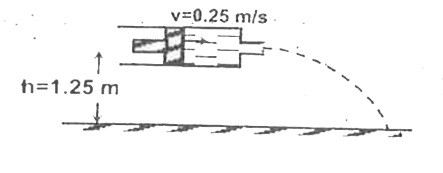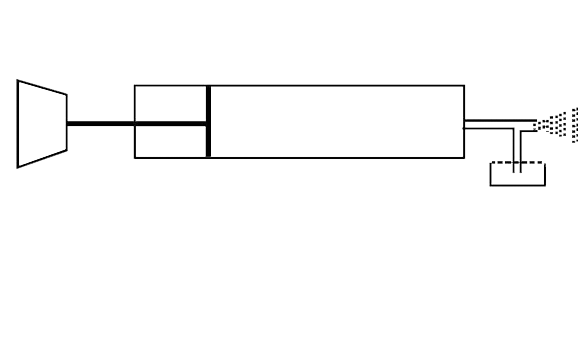Why does the liquid rise in a syringe when its piston is pulled up?
To understand why the liquid rises in a syringe when its piston is pulled up, we can break down the explanation into a series of steps:
1. Understanding Pressure:
- Liquids and gases move from regions of high pressure to regions of low pressure. This is a fundamental principle of fluid dynamics.
Hint: Remember that pressure differences drive the movement of fluids.
2. Pulling the Piston:
- When the piston of the syringe is pulled upwards, it creates a larger volume inside the barrel of the syringe. This action decreases the pressure inside the barrel.
Hint: Think about how pulling the piston changes the space available for the liquid.
3. Creation of Low Pressure:
- As the piston is pulled, the pressure inside the barrel becomes lower than the atmospheric pressure outside the syringe. This pressure difference is crucial for the movement of the liquid.
Hint: Consider how the air pressure outside the syringe compares to the pressure inside after pulling the piston.
4. Movement of Liquid:
- The liquid at the open end of the syringe is now subjected to higher atmospheric pressure compared to the low pressure inside the barrel. This difference in pressure causes the liquid to be pushed into the syringe.
Hint: Visualize how the higher pressure outside pushes the liquid into the lower pressure area.
5. Resulting Action:
- As a result of this pressure difference, the liquid rises in the syringe. The atmospheric pressure acts to fill the low-pressure area created by the pulled piston.
Hint: Think about how the liquid behaves when there is a force acting on it from a higher pressure area.
Conclusion:
The liquid rises in a syringe when its piston is pulled up due to the creation of a low-pressure area inside the barrel, which allows the higher atmospheric pressure outside to push the liquid into the syringe.
- Liquids and gases move from regions of high pressure to regions of low pressure. This is a fundamental principle of fluid dynamics.
- When the piston of the syringe is pulled upwards, it creates a larger volume inside the barrel of the syringe. This action decreases the pressure inside the barrel.
- As the piston is pulled, the pressure inside the barrel becomes lower than the atmospheric pressure outside the syringe. This pressure difference is crucial for the movement of the liquid.
- The liquid at the open end of the syringe is now subjected to higher atmospheric pressure compared to the low pressure inside the barrel. This difference in pressure causes the liquid to be pushed into the syringe.
- As a result of this pressure difference, the liquid rises in the syringe. The atmospheric pressure acts to fill the low-pressure area created by the pulled piston.
The liquid rises in a syringe when its piston is pulled up due to the creation of a low-pressure area inside the barrel, which allows the higher atmospheric pressure outside to push the liquid into the syringe.
Topper's Solved these Questions
- FLUIDSBOOK - ICSECHAPTER - FLUIDSEXERCISE - TOPIC 2 (2 Marks Questions )
45 Videos
- FLUIDSBOOK - ICSECHAPTER - FLUIDSEXERCISE - TOPIC 2 (3 Marks Questions )
23 Videos
- FLUIDSBOOK - ICSECHAPTER - FLUIDSEXERCISE - TOPIC 1 (3 Marks Questions )
18 Videos
- ELECTRICITY AND MAGNETISM BOOK - ICSECHAPTER - ELECTRICITY AND MAGNETISM EXERCISE - TOPIC 2 Magnetism (4 Marks Questions )
6 Videos
- HEAT AND ENERGYBOOK - ICSECHAPTER - HEAT AND ENERGYEXERCISE - EXERCISE -6(D) Multiple Choice Question)
4 Videos
Similar Questions
A syringe of diameter D = 8 mm and having a nozzie of diameter d = 2 mm is placed horizontally at a height of 1.25 m as shown in the figure . An incompressible and non - viscous liquid is filled in syringe and the piston is moved at speed of 0.25 m/s .Find the range of liquid jet on the ground.

View SolutionA piston is fitted in a cylindrical tube of small cross section with the other end of the tube open. The tube resonates with a tuning fork of frequency 512 Hz. The piston is gradually pulled out of the tube and it is found that a second resonance occurs when the piston is pulled out through a distance of 32.0 cm. Calculate the speed of sound in the air of the tube.
View Solution
Knowledge Check
A solid sphere of radius R made of a material of bulk modulus K is surrounded by a liquid in a cylindrical container. A massless piston of area A floats on the surface of the liquid. When a mass M is placed on the piston to compress the liquid the fractional change in the radius of the sphere, δR/R, is .............
AMg/2AKBMg/3AKCMg/AKD2Mg/3AK
Why does the temperature of a gas increase when it is suddenly compressed?
View SolutionWhy does the boiling point of liquid rise on increasing pressure ?
View SolutionHow does the density of a liquid change with the rise in its temperature?
View Solution_E01_216_Q01.png)
A syringe containing water is held horizontally with its nozzle at a height h above the ground as shown in fig the cross sectional areas of the piston and the nozzle are A and a respectively the piston is pushed with a constant speed v. Find the horizontal range R of the stream of water on the ground.
View SolutionA solid sphere of radius R made of a material of bulk modulus B is surrounded by a liquid in a cylindrical container. A massless piston of area A (the area of container is also A) floats on the surface of the liquid. When a mass M is placed on the piston to compress the liquid , fractional change in radius of the sphere is MgαAB. Find the value of α.
View SolutionA spray gun is shown in the figure where a piston pushes air out of a nozzle. A thin tube of uniform cross section is connected to the nozzle. The other end of the tube is in a small liquid container. As the piston pushes air through the nozzle, the liquid from the container rises into the nozzle and is sprayed out. For the spray gun shown, the radii of the piston and the nozzle are 20mm and 1mm respectively. The upper end of the container is open to the atmosphere.

If the density of air is ρa, and that of the liquid ρl, then for a given piston speed the rate (volume per unit time) at which the liquid is sprayed will be proportional to
View SolutionA liquid rises in a capillary tube when the angle of contact is:
View Solution
